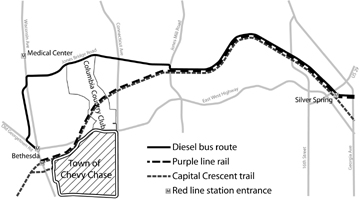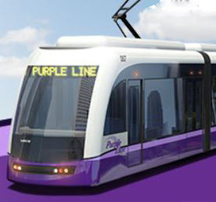Jones Bridge Road Busway
In 2003, the newly elected Ehrlich administration came into office after making campaign promises both to Purple Line opponents and to Washington-area commuters who want better transportation. They chose not to kill the Purple Line outright, but instead embarked on a policy that their own appointee to the Metro board later described as “obfuscate, alter, study and delay.” Progress on light rail came to a near-standstill while new, less expensive bus alternatives were considered.
The option that eventually emerged is a bus alternative that takes the same route as light rail from downtown Silver Spring to Jones Mill Road and then deviates onto existing roads. It follows Jones Bridge Road from Jones Mill to Wisconsin Avenue, and then turns south and uses Woodmont Avenue to reach the Bethesda Metro. (Additionally, a busway that follows the same route as light rail was already part of the study.)

The Ehrlich administration admitted the reason for proposing this alternative. It wasn't transportation planning, but a desire to keep mass transit away from Columbia Country Club. The Governor was quoted in the Gazette Newspapers as saying “It will not go through the Country Club.” Secretary of Transportation Flanagan tried to put a different spin on it, saying his priority was preserving the present status of the gravel trail along the right of way, but Flanagan conceded that “The governor happens to love golf.”
As soon as the idea emerged, the Montgomery County Planning Board took an initial look at the specifics of putting a high-speed busway on Jones Bridge Road and found the concept to be grievously flawed if not entirely impractical. It was unanimously rejected by the county council. With the arrival of the O'Malley administration, the idea lost traction, although the idea of running buses in the regular traffic lanes of Jones Bridge Road remained in the Maryland Transit Administration study.
In early 2008, however, the Jones Bridge Road busway got new impetus. The Town of Chevy Chase appropriated $250,000 to hire consultants to review the state's Purple Line studies. In March, the consultants, Sam Schwartz PLLC, made a presentation to the town council which recommends a Jones Bridge Road busway – modified to move the buses faster than the MTA believes possible. ACT's review of this presentation has found numerous distortions and flat-out mistakes. Also, the Maryland Dept. of Transportation, in this letter, identified severe flaws in the Schwartz firm's final report.
The Maryland Transit Administration's detailed analysis of alternatives was completed in September 2008. It confirmed that the route that passes through the country club is far superior to Jones Bridge Road. It found - after additional analysis of the Town of Chevy Chase's proposals - that the Jones Bridge Road route “would have the slowest travel time between Silver Spring and downtown Bethesda.”
Is It Really About the Trail?
This move by the town, following on the revelation of Columbia Country Club's sponsorship of so-called “grass roots” opposition to the Purple Line, demonstrates once again the emptiness of the Purple Line opponents' slogan “save the trail.” The Town of Chevy Chase has no problem with diesel buses running along the trail on the other side of Rock Creek Park. Indeed, as the Beyond DC blog points out, the bike trail could be avoided entirely by routing a busway along Leland Street. But Leland Street passes through the Town of Chevy Chase. In their own backyards, even quiet nonpolluting light rail is unacceptable, and a busway is out of the question.
The Town has a similar double standard for safety. Under the busway plan, buses would run all day past North Chevy Chase Elementary School, located on Jones Bridge Road, at 30 or 40 mph. In fact, the Town thinks the state's plan doesn't move the buses fast enough. Mayor Linna Barnes asked the state to study a Jones Bridge Road bus route with “travel times comparable to [other] BRT and LRT alternatives” – all with vehicles moving at 40 mph or faster. At the same time, the Town is demanding a 15-mph speed limit on streets around Chevy Chase Elementary, located within its own boundaries.
Why Rail and Not Bus?
ACT believes that improvements to the regional bus system are critical to solving the developing mobility crisis. Rail transit is expensive and cannot be cost-effectively extended outward from Washington to every low density suburb. But buses cannot substitute for building rail along corridors of the heaviest transit use. The alignment of the proposed Inner Purple Line includes some of the highest density communities in Maryland existing outside of downtown Baltimore. These communities already support extensive bus service, and they need the major east-west transit line upgraded to rail.
In recent years, a significant lobby in support of so-called bus rapid transit (BRT) developed, and it found a welcoming home in the administration of President George W. Bush. However, this bus lobby really has its roots in the 1940s, when oil, gas, asphalt and rubber interests teamed up to purchase and dismantle interurban railroad systems across the United States. Bus proponents tend to deny data that clearly indicates that Americans have shown strong preference for rail transit. Bus transit may be more flexible, but the economic strength of rail over bus is partly due to the fact that rail lines send a clear indicator to private investors about the seriousness of the public investment. The message is that we will not allow our communities to be abandoned. This contrasts to bus lines which may disappear at any time.
Light rail also is far more friendly to the environment than any bus system. Claims to the contrary made by the bus lobby have been thoroughly debunked by Christopher Puchalsky, a researcher at the University of Pennsylvania. For his detailed comparison of pollution emitted by light rail and bus rapid transit, click here.
An eloquent defense of rail is provided by Paul Weyrich, the recently deceased conservative commentator.

